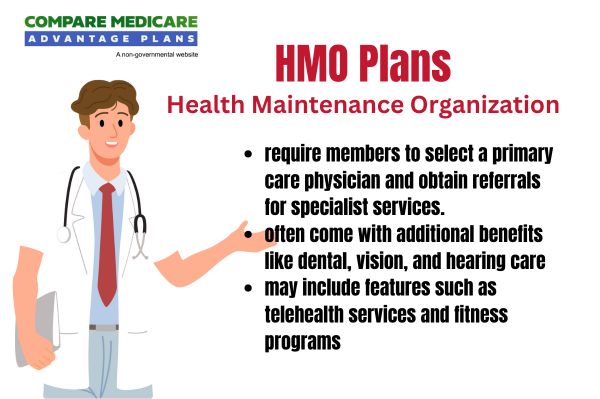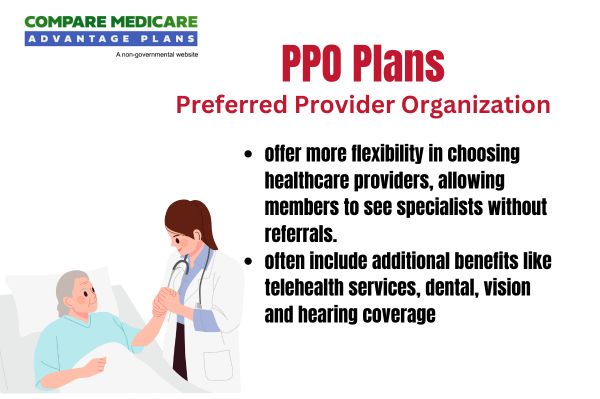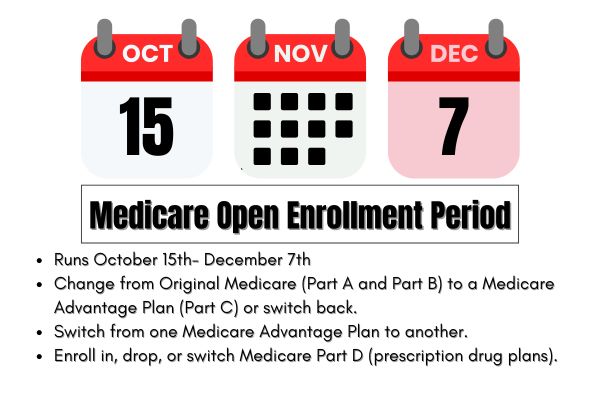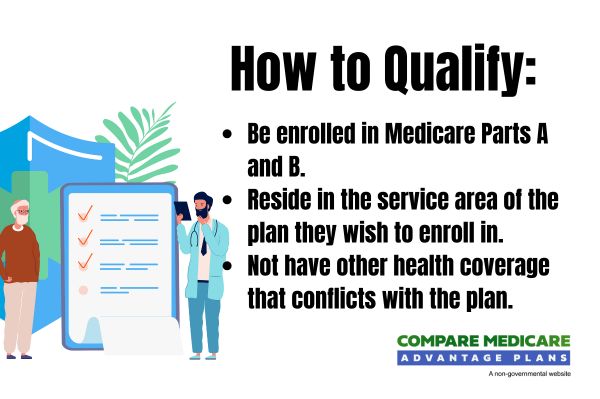




Medicare Advantage Plans Texas 2026
Looking into the potential Medicare Advantage Plans in Texas for 2026? Discover the available plan options, potential benefits, and how to enroll.
Key Takeaways
- Texas Medicare Advantage Plans combine the Original Medicare benefits, sometimes offering additional services like dental, vision, and hearing coverage, which are not available under Original Medicare.
- There are various types of Medicare Advantage Plans in Texas, including HMOs, PPOs, and Special Needs Plans, each designed to meet different healthcare needs and preferences.
- Understanding cost structures, which might include premiums and out-of-pocket maximums, will likely be essential as certain Medicare Advantage Plans may offer lower costs and financial protection compared to Original Medicare.
Compare Plans in One Step!
Enter Zip Code
Understanding Texas Medicare Advantage Plans 2026

Medicare Advantage Plans in Texas have been a popular choice for many seniors in recent years, offering a blend of Medicare Part A (hospital insurance) and Part B (medical insurance) under a single plan provided by private insurers. Unlike Original Medicare, which is directly administered by the federal government, Texas Medicare Advantage Plans will likely be designed to cover medically necessary services that Original Medicare does, and often more. This might include additional benefits like vision, dental, and hearing coverage.
However, not all Medicare Advantage Plans are the same. The cost-sharing, coverage options, and healthcare provider networks may vary significantly from one plan to another. Beneficiaries must carefully compare plans to find one that aligns with their healthcare needs and financial situation. These plans are also regulated to help ensure they could offer adequate coverage and help protect beneficiary rights. Understanding these fundamental aspects could help you navigate your choices more effectively.
This article will explore the various types of Texas Medicare Advantage Plans, their potential benefits, and their comparison to Original Medicare. This comprehensive guide aims to equip you with the knowledge you need to make informed decisions about your healthcare.
Types of Texas Medicare Advantage Plans Available
In Texas, there will likely be several types of Medicare Advantage Plans to choose from, catering to various healthcare needs and preferences. These include Health Maintenance Organization (HMO) plans, Preferred Provider Organization (PPO) plans, and Special Needs Plans (SNPs).
Understanding the unique benefits and structures of each type is crucial for selecting the best plan for your situation.
HMO Plans

Health Maintenance Organization (HMO) plans may be a common choice for many Texans due to the potential reduction of premiums and out-of-pocket costs. HMO plans require members to select a primary care physician (PCP) who coordinates all their healthcare needs. This means that for most specialist visits, members might need a referral from their PCP. While this might seem restrictive, it ensures that your care is well-coordinated and typically more affordable.
Certain HMO plans may offer additional benefits that could go beyond what Original Medicare offers, such as dental, hearing, and vision coverage. These potential benefits could be a significant advantage for those looking to cover more comprehensive healthcare needs. HMO plans focus on preventative care and effective management of chronic conditions to promote long-term health.
PPO Plans

Preferred Provider Organization (PPO) plans offer greater flexibility compared to HMOs. With a PPO plan, you can see any Medicare-approved provider, but you might save money by using doctors within the plan’s network. The ability to see specialists without a referral could be a significant advantage for those with specific healthcare needs. However, seeing out-of-network providers may come at a higher cost.
This flexibility and affordability will likely make PPO plans an attractive option for many beneficiaries.
Special Needs Plans (SNPs)

Special Needs Plans (SNPs) are tailored for individuals with specific health conditions or circumstances. These plans must include Medicare drug coverage and might require members to have a primary care doctor to coordinate their care. SNPs are designed to provide specialized care and support for groups like those with chronic conditions, dual eligibles (those who qualify for both Medicare and Medicaid), and residents in long-term care facilities.
There are three main types of SNPs: Dual Eligible SNPs (D-SNPs), Chronic Condition SNPs (C-SNPs), and Institutional SNPs (I-SNPs). Each type prioritizes tailored benefits and care coordination to meet the unique needs of their enrollees.
Overview of Texas Medicare Advantage Plans 2026
Texas Medicare Advantage Plans will likely be designed to offer a comprehensive healthcare solution by combining medical and hospital coverage. Some plans might include additional benefits like dental, vision, and hearing services, which are not covered by Original Medicare. The coordinated care provided through a network of healthcare providers could potentially ensure that beneficiaries receive efficient and effective medical attention.
Some Medicare Advantage plans in Texas may be specifically tailored for individuals eligible for both Medicare and Medicaid, known as Dual Eligible Special Needs Plans (D-SNP). Recognizing the broad scope of these plans highlights the value they could offer beyond traditional Medicare coverage.
Potential Services and Benefits
Medicare Advantage plans in Texas offer a wide range of services, including hospital care and outpatient care. Some plans may go beyond the standard Medicare coverage by potentially offering additional benefits such as vision, hearing, and dental care.
Prescription drug coverage could be another potential benefit in certain Medicare Advantage plans, which may help reduce out-of-pocket costs for medications. This potential inclusion could be particularly beneficial for those with chronic conditions requiring regular medication. Additionally, emergency care and urgent care services are generally covered, providing peace of mind knowing that you can get the necessary care in critical situations.
Possible Benefits of Texas Medicare Advantage Plans 2026
One of the potential advantages of some Medicare Advantage plans could be the potential inclusion of extra benefits not available with Original Medicare, such as vision, dental, and hearing coverage. Certain Advantage plans could potentially offer reduced premium options, likely making them accessible to a broader range of seniors.
Another potential benefit could be the annual out-of-pocket maximum, which caps the total expenses a beneficiary has to pay each year. This financial protection could be crucial for preventing unexpected medical costs from becoming a burden.
Special Needs Plans (SNPs) under Medicare Advantage cater specifically to individuals with chronic conditions or those eligible for both Medicare and Medicaid, providing tailored benefits and care coordination. These potential features will likely make Medicare Advantage plans a comprehensive and financially viable option for many Texans.
Enrollment Process for Texas Medicare Advantage Plans 2026
Enrolling in a Texas Medicare Advantage Plan requires eligibility for both Medicare Part A and Part B and residing within the plan’s service area. Having your Medicare details ready is essential to streamline the enrollment process. Understanding when and how to enroll can help you take full advantage of these plans.
Several specific enrollment periods are important to be aware of, each catering to different stages and circumstances in a beneficiary’s life. These include the Initial Enrollment Period, the Open Enrollment Period, and Special Enrollment Periods triggered by specific life events. Navigating these periods effectively ensures that you can access the healthcare coverage you need when you need it.
When to Enroll
The Initial Enrollment Period (IEP) is the first opportunity for individuals to enroll in Medicare and, subsequently, a Medicare Advantage Plan. This period begins three months before you first become eligible for Medicare and lasts for three months after. Enrolling during this time ensures that your coverage starts as soon as you are eligible, avoiding any gaps in your healthcare coverage.

If you’re interested in switching plans or enrolling for the first time outside of your IEP, you can continue to learn about other enrollment opportunities. The Annual Enrollment Period (AEP) and the Medicare Advantage Open Enrollment Period (OEP) provide additional windows for making changes to your coverage. Understanding these periods can help you make the most of your Medicare benefits.
Different Enrollment Periods
The Open Enrollment Period (OEP) for Medicare runs from October 15 to December 7 each year. During this time, you can join, switch, drop, or make changes to your Medicare Advantage plan. This period is crucial for reviewing your current plan and making adjustments based on your healthcare needs for the upcoming year.
Special Enrollment Periods (SEPs) allow for changes in your Medicare plan due to specific life events, such as moving out of your plan’s service area or losing other health coverage. These periods provide flexibility to ensure that your healthcare coverage adapts to your changing circumstances. Understanding these enrollment periods can help you take timely action to maintain continuous and appropriate coverage.
OEP, AEP, Special Enrollment
The Medicare Advantage Open Enrollment Period (OEP) runs from January 1 to March 31 each year and allows individuals who are already enrolled in a Medicare Advantage Plan to switch to a different Medicare Advantage Plan or return to Original Medicare. Enrollment changes made during this period take effect the first month following the plan’s receipt of the request, providing flexibility for beneficiaries to adjust their coverage based on their evolving healthcare needs.
Special Enrollment Periods (SEPs) are triggered by specific life events, such as moving out of your plan’s service area, losing other health coverage, or experiencing changes in eligibility for Medicaid. SEPs offer a crucial safety net, ensuring that beneficiaries can join or switch plans outside the regular enrollment periods when life circumstances change. This flexibility helps maintain continuous and appropriate healthcare coverage.
Potential Costs Associated with Texas Medicare Advantage Plans 2026
Understanding the possible costs associated with Medicare Advantage Plans in Texas is essential for making an informed decision. These costs might vary widely depending on the specific plan, which may include various factors like premiums, co-pays, and out-of-pocket maximums.
By exploring these potential costs, you can find a plan that fits your budget while providing the comprehensive coverage you need.
Premiums and Co-Pays
Medicare Advantage plans in Texas will likely offer a range of premium options, possibly making these plans financially accessible for many beneficiaries.
Co-pays for services under certain Medicare Advantage plans may vary significantly based on the type of service and the specific plan selected. These various cost-saving measures could potentially ensure that beneficiaries can manage their healthcare expenses more effectively.
Out-of-Pocket Maximums
One of the potential financial protections that may be offered by Medicare Advantage plans will likely be the out-of-pocket maximum, which could potentially limit the total amount a beneficiary has to spend on covered services in a given year. Once this limit is reached, the plan covers up to 100% of the costs for covered services, possibly protecting beneficiaries from catastrophic health expenses.
Out-of-pocket maximums may also vary by plan, so it’s essential to review this aspect when choosing a Medicare Advantage plan. This potential financial protection could be integral to making Medicare Advantage plans an attractive option for many beneficiaries.
Potential Services and Benefits
Medicare Advantage plans in Texas are required to cover all services provided under Original Medicare, including hospital care (Part A) and outpatient services (Part B). Certain plans may also offer additional benefits that could go beyond Original Medicare, such as vision, dental, and hearing coverage, possibly providing a more comprehensive healthcare package. This additional coverage may help ensure that beneficiaries could have access to necessary medical attention without worrying about high out-of-pocket costs.
Prescription drug coverage, known as Medicare Part D, may also be included in certain Medicare Advantage plans, which could help reduce out-of-pocket costs for certain medications.
How to Qualify for Texas Medicare Advantage Plans 2026

To qualify for a Texas Medicare Advantage Plan, individuals must first be eligible for Medicare, which typically means being 65 or older or having a qualifying disability. Additionally, individuals must have both Medicare Part A and Part B and live within the plan’s service area. Knowing the eligibility criteria helps determine if a Medicare Advantage plan suits you.
Comparing Texas Medicare Advantage Plans to Original Medicare
Comparing Texas Medicare Advantage Plans to Original Medicare might reveal several differences. Medicare Advantage Plans, also known as Part C, will likely be offered by private insurers and combine medical and sometimes prescription drug coverage with additional benefits not typically included in Original Medicare.
Grasping these potential differences could aid beneficiaries in making informed healthcare choices.
Coverage Differences
One of the potential differences between Original Medicare and Medicare Advantage Plans might be the network of providers. Original Medicare allows beneficiaries to see any provider that accepts Medicare, whereas Medicare Advantage Plans may restrict beneficiaries to a network of providers. However, certain Medicare Advantage Plans may also include additional benefits, such as dental, vision, and hearing services, that Original Medicare does not cover. This added coverage could be a significant advantage for those looking for more comprehensive healthcare.
Cost Comparisons

Some Medicare Advantage Plans may offer lower out-of-pocket costs compared to Original Medicare. While Original Medicare does not have an out-of-pocket maximum, Medicare Advantage Plans might set this limit, possibly providing financial protection against high medical expenses. This potential difference could make Medicare Advantage Plans more appealing to those concerned about unpredictable healthcare costs.
Emergencies and Referrals
In HMO Medicare Advantage plans, a primary care provider (PCP) must refer you to see a specialist for coverage to apply. However, there are exceptions to this referral requirement, including emergency services, out-of-area urgent care, and temporary out-of-area dialysis. This structure likely ensures that care is well-coordinated while still providing flexibility for urgent medical needs.
Emergency care is always covered under Medicare Advantage plans, providing flexibility in urgent situations. This means that even if you are outside your network, you can still receive emergency care without worrying about coverage issues. Knowing these policies could help ensure access to necessary medical attention when it matters most.
Summary
Texas Medicare Advantage Plans for 2026 will likely offer a comprehensive and flexible approach to healthcare, combining the benefits of Medicare Part A, Part B, and sometimes additional services and various financial protections. Understanding the types of plans available, their potential benefits, and the enrollment process can help you make informed decisions about your healthcare coverage. As you navigate your options, remember that these plans will likely be designed to enhance your overall well-being and provide peace of mind. Take advantage of the resources available to choose the best plan for your needs and enjoy a healthier future.
Frequently Asked Questions
→ What are the different types of Texas Medicare Advantage Plans available?
Texas Medicare Advantage plans include HMO, PPO, and Special Needs Plans (SNPs), providing options tailored to diverse healthcare requirements.
→ When can I enroll in a Medicare Advantage Plan?
You can enroll in a Medicare Advantage Plan during the Initial Enrollment Period, the Open Enrollment Period from October 15 to December 7, or during Special Enrollment Periods due to qualifying life events. Be sure to check your eligibility for these enrollment options.
→ What are the potential costs associated with Medicare Advantage Plans?
Some Medicare Advantage Plans might involve premiums, co-pays, and annual out-of-pocket maximums. It’s important to review these costs to ensure they align with your healthcare needs.
→ How could Medicare Advantage Plans compare to Original Medicare?
Some Medicare Advantage Plans may provide additional benefits, such as dental, hearing, and vision coverage, as well as prescription drug coverage. Certain plans may also offer financial protections like out-of-pocket maximums that Original Medicare does not.
→ What should I do in case of an emergency under a Medicare Advantage Plan?
In case of an emergency under a Medicare Advantage Plan, you can seek emergency care without a referral, and you will likely be covered regardless of whether you are within your network for PPO plans. It’s crucial to prioritize your health and safety in these situations.

ZRN Health & Financial Services, LLC, a Texas limited liability company




